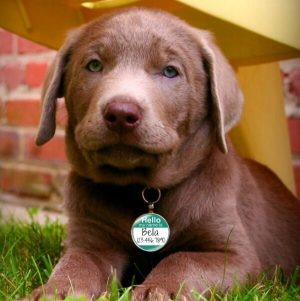Most dogs love having a good run off their lead. But before you let your pooch loose, you need to be confident that they’ll always come back when you call; whatever’s going on around them.
Teach your dog that coming back to you is always a good thing, and will result in tasty snacks, a fuss, or whatever reward they like best.
Teaching your pooch their name makes it easy for you to grab their attention when you need it. This can be a lifesaver if you need them to focus on you quickly to save them from harm. After you’re confident you can get their attention, you can add in your chosen recall cue.
Choose a short, snappy word like ‘come’ or ‘here’, or a whistle if you prefer. Also add in a visual cue, like holding your arms open wide, in case they can’t hear you. Make sure everyone in your household knows which word and movement you’re using to prevent your dog getting confused.
Use your recall cue sparingly, giving your dog at least five seconds to respond before calling again. Don’t call again if you think they’re unlikely to return, as this could teach them that it’s okay to not come back.
Start indoors, in your garden, or in another enclosed space with some tasty treats to hand. Get your dog’s attention with their name, then use your recall cue and take a step away from them. Reward them with praise and a tasty treat when they come to you.
Make sure your rewards are exciting and tempting – especially if your dog has come away from something particularly interesting (like a squirrel or another dog). When calling them, use a happy, excited voice and welcoming body language (crouched down, arms open).
Always praise your dog for coming back no matter how long it takes. As your dog improves, you won’t need to give them a treat every time they come back. But remember to reward them every so often to keep them motivated.
Gradually increase the distance between you and your dog and the level of distractions you call them away from. Eventually leaving the garden and venturing out into the world. Let them move away from you before using your recall cue, and use a long line attached to their harness to keep them safe during training.
If they ignore you, stay calm – getting angry or shouting will make them not want to come back to you. Instead, gently guide them in with the long line, or go and collect them. Never use the lead to pull your dog towards you. This could make them not want to return.
Reward them with high-value treats when they return without this extra guidance, so they build up a positive association with coming when called.
When you let your dog off their lead, a whole world of choice opens up to them. They could decide that chasing a squirrel or playing with another dog is more exciting than coming back to you (they see you every day, after all).
However, running off can be very unsafe for your dog. Busy roads, other dogs, livestock, and dog thieves are just a few of the possible dangers if they’re running around unsupervised.
If your pooch keeps darting off when you call them, stick with training on a long lead attached to a harness, and only let them off-lead in secure areas. Only let your dog off their lead in open spaces when you’re confident they’ll come back when called.
If you aren’t seeing an improvement with your dog’s training, you may wish to contact aqualified trainer or behaviorist to help.
Always ensure your dog is wearing acollar and ID tag at all times in public and that microchip details are kept up-to-date. This hopefully will someday become law in Morocco and will help you reunite with your best pal if they get lost.

Si vous avez trouvé cette page utile, veuillez considérer laisser un petit don pour nous aider à créer des conseils plus utiles.
Vous pouvez également inscrivez-vous à notre newsletter gratuite pour plus de trucs et astuces et pour vous tenir au courant de notre travail.
info
spadumaroc.com
© 2000-2025 La Société Protectrice des Animaux du Maroc/SPA du Maroc.
Tous droits réservés.
La SPA du Maroc vient en aide aux animaux dans tout le pays.
La Société Protectrice des Animaux du Maroc est une organisation à but non lucratif.
Organisme de bienfaisance enregistré nº. 1490/2021.
Transparence dans la couverture.
| Biscuit | Durée | Description |
|---|---|---|
| cookielawinfo-checkbox-analytics | 11 mois | This cookie is set by GDPR Cookie Consent plugin. The cookie is used to store the user consent for the cookies in the category "Analytics". |
| cookielawinfo-checkbox-fonctionnel | 11 mois | The cookie is set by GDPR cookie consent to record the user consent for the cookies in the category "Functional". |
| cookielawinfo-case à cocher-nécessaire | 11 mois | This cookie is set by GDPR Cookie Consent plugin. The cookies is used to store the user consent for the cookies in the category "Necessary". |
| cookielawinfo-checkbox-autres | 11 mois | This cookie is set by GDPR Cookie Consent plugin. The cookie is used to store the user consent for the cookies in the category "Other. |
| cookielawinfo-checkbox-performance | 11 mois | This cookie is set by GDPR Cookie Consent plugin. The cookie is used to store the user consent for the cookies in the category "Performance". |
| visualisé_cookie_policy | 11 mois | Le cookie est défini par le plugin GDPR Cookie Consent et est utilisé pour stocker si l'utilisateur a consenti ou non à l'utilisation de cookies. Il ne stocke aucune donnée personnelle. |